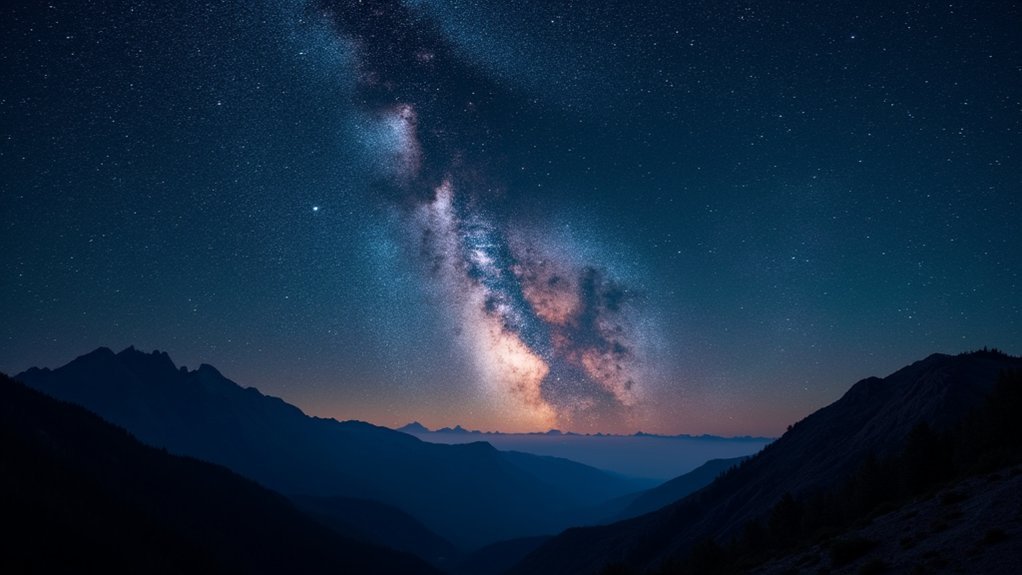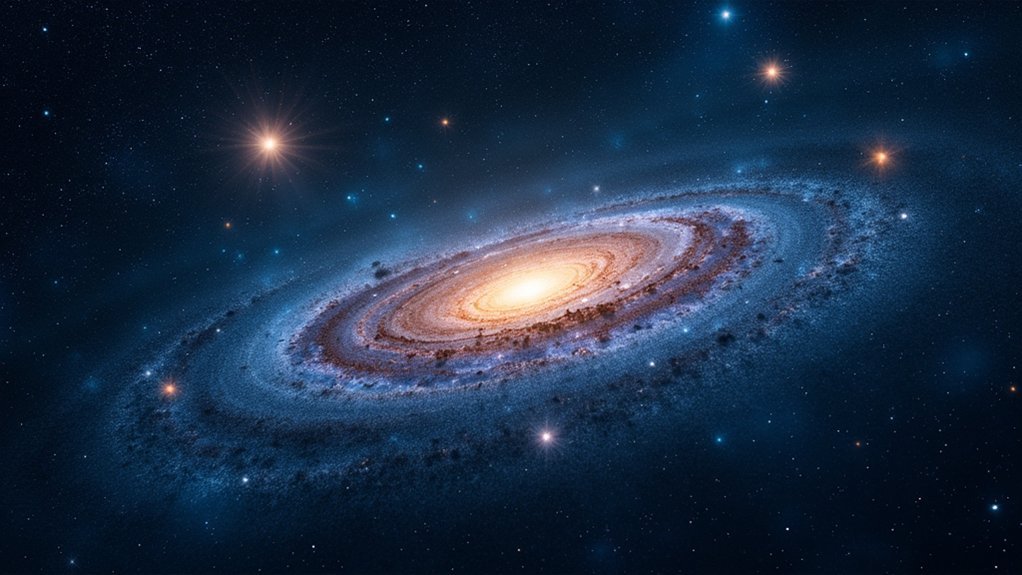Budget astrophotographers can capture stunning celestial objects tonight with minimal equipment. The Orion Nebula offers rich details in winter, while the Andromeda Galaxy reveals its spiral structure using just a DSLR and 135mm lens. Spring brings the Leo Triplet, summer showcases the North America Nebula, and fall highlights the Triangulum Galaxy. You’ll achieve impressive results by using free software like DeepSkyStacker and applying basic processing techniques. The night sky holds countless treasures waiting for your camera.
What Stars Can Budget Astrophotographers Shoot Tonight?

When darkness falls, the night sky transforms into a canvas of astronomical wonders accessible even to those with modest equipment. Despite light pollution challenges, several celestial objects remain within reach for budget astrophotographers year-round.
Winter nights offer the breathtaking Orion Nebula, capturing rich details with minimal gear, while the Pleiades’ stunning blue reflection nebulae shine during colder months.
The Orion Nebula dazzles winter observers, offering celestial splendor alongside the Pleiades’ ethereal blue veils.
Come spring, try photographing the Leo Triplet for multiple galaxies in one frame.
Summer presents the perfect opportunity to capture the North America Nebula with longer exposures.
As fall arrives, the Andromeda Galaxy becomes your prime target, revealing its spectacular spiral structure with just a DSLR and 135mm lens.
These deep space objects prove that impressive astrophotography doesn’t require expensive equipment—just patience and proper planning.
Bright Galaxies Visible With Basic DSLR Equipment
Despite what many beginners believe, capturing distant galaxies doesn’t require expensive telescope setups or specialized equipment. Your basic DSLR with a decent lens can reveal stunning cosmic neighbors when paired with the right techniques.
| Galaxy | Key Feature | Equipment Needs |
|---|---|---|
| Andromeda (M31) | Naked-eye visible | Standard DSLR, tripod |
| Whirlpool (M51) | Spiral structure | DSLR, stable mount, longer exposures |
| Sombrero (M104) | Distinctive shape | Works in light pollution, basic equipment |
For budget astrophotographers, the Triangulum Galaxy (M33) rewards patience with longer exposure times, while the Sculptor Galaxy (NGC 253) offers southern hemisphere observers an easy target. Remember that a stable mount becomes essential as you increase exposure times to reveal these bright galaxies’ subtle details.
Galaxy Clusters and Groups for Entry-Level Trackers

Although individual galaxies offer spectacular targets, galaxy clusters and groups present budget astrophotographers with even more impressive cosmic vistas on a single frame.
Tonight, you can point your entry-level tracker toward the Leo Triplet, where M65, M66, and NGC 3628 interact in the spring sky—ideal for beginners.
The Coma Cluster showcases over a thousand galaxies in Coma Berenices, accessible even with modest equipment.
Similarly, the Virgo Cluster, our nearest large galaxy cluster, reveals notable members like M87 and M86 during springtime.
Don’t overlook the Hercules Cluster (M13), a brilliant globular cluster that reveals stunning detail with longer exposures.
For remarkable star fields, the Double Cluster in Perseus delivers breathtaking results that will reward your patience with budget gear.
Seasonal Galaxy Targets Throughout the Year
The night sky transforms throughout the seasons, offering budget astrophotographers a rotating gallery of celestial treasures to capture. Your camera can document this celestial parade even with light pollution challenges.
Winter brings Andromeda Galaxy (M31) into perfect position—an ideal target for your 135mm lens.
Spring reveals the Leo Triplet, where proper polar alignment exposes three distinct galaxies in one imaging session.
Summer nights showcase colorful nebulae like the Lagoon (M8) and North America (NGC 7000), perfect for DSLR setups and some of the best astrophotography opportunities for beginners.
When fall arrives, turn your attention to the Triangulum Galaxy (M33), whose sprawling structure rewards longer exposures.
These seasonal targets provide year-round opportunities to enhance your skills without breaking your budget.
Image Processing Techniques for Galaxy Detail on a Budget

Four essential processing techniques can transform your raw galaxy images into stunning cosmic portraits without expensive software. Your budget astrophotography setup doesn’t limit your ability to capture breathtaking galaxy detail when you follow this guide.
| Technique | Budget Solution | Result |
|---|---|---|
| Stacking | DeepSkyStacker (free) | Enhanced signal-to-noise ratio |
| Gradient Removal | Free plugins in GIMP | Mitigates light pollution |
| Stretching | Histogram adjustments | Reveals hidden structure |
Don’t underestimate what you can achieve with careful image processing. Apply color calibration by referencing known star colors in your frame. If shooting from urban areas, consider investing in affordable light pollution filters—they’re worth every penny when you see how they preserve delicate galaxy features that would otherwise be washed out.
Frequently Asked Questions
What Is the Best ISO Setting for Stars?
For stars, you’ll typically want to use ISO 1600-3200 as your starting point. You can push to 6400 in very dark skies, but always check your results on a computer for noise levels.
Who Was the First Astrophotographer?
Louis Daguerre captured the first astronomical photograph in 1839, using the daguerreotype process to image the moon. You’ll find it interesting that John William Draper followed with his moon photograph in 1840.
What Time of Day Is Best for Astrophotography?
The best time for astrophotography is during the night when it’s darkest – typically from a few hours after sunset until dawn. You’ll get clearest images during new moon phases with minimal light pollution.
What Is the Best Focal Length for Star Photography?
For star photography, you’ll want a focal length between 24mm and 135mm. Use wider lengths (24-35mm) for expansive night sky scenes and longer lengths (85-135mm) to capture detailed celestial objects or clusters.
In Summary
You don’t need expensive gear to capture stunning galaxies tonight. With your basic DSLR, entry-level tracker, and free processing software, the universe is within reach. Adjust your seasonal targets throughout the year, apply simple stacking techniques, and you’ll be amazed at what details emerge. The night sky isn’t reserved for professional observatories—it’s waiting for your budget setup right now.





Leave a Reply